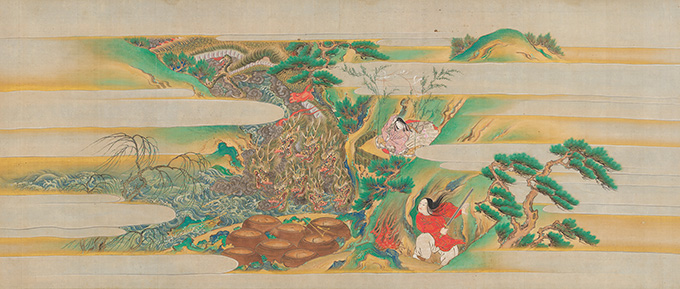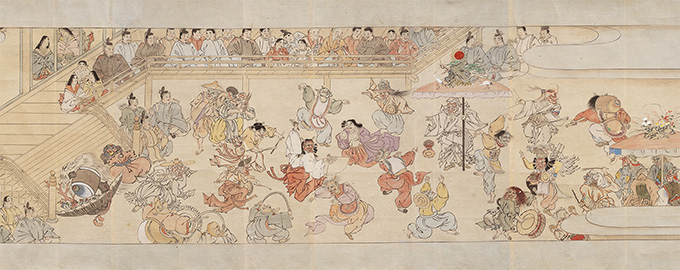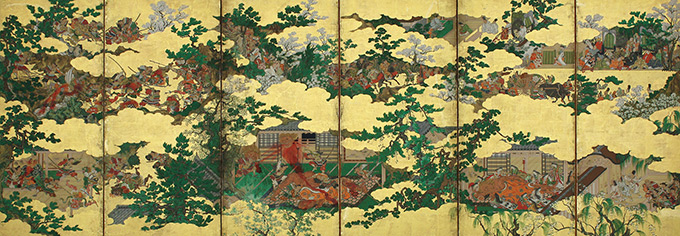- Calendar
- Online Ticket Sales
- Access
- JA
- EN
Shutendōji Begins: Tales of the Demon Slayer Throughout the Ages
April 29 to June 15, 2025
*Download the list of changes in works on display
*There will be an exhibition change during the course of exhibition.
*Photography is not permitted in this exhibition
The list of changes in worksPDF
*The order of chapters may change at the exhibition venue.
SECTION ONE:
The Unveiling of Kanō Motonobu’s Picture Scroll of the Tale of Shutendōji
The Tale of Shutendōji, an Important Cultural Property in the collection of the Suntory Museum of Art (hereafter the Suntory Scrolls), is an important picture scroll in part because its production context, date, and provenance are clear. It is known that the warlord Hōjō Ujitsuna of Odawara commissioned the work in 1522 (Daiei 2), and that its creation was overseen by Kanō Motonobu, the painter credited for establishing the foundation of the Kanō school.
Motonobu’s The Tale of Shutendōji would go on to become one of the most representative works of the Kanō School, and would be repeatedly copied by painters both in and out of the school during the Edo period. Indeed, the Suntory Scrolls represent the “beginning of the pictorialization” of Shutendōji.
It is possible that Motonobu’s picture scroll influenced the Noh performance of tale. In the Noh play Mount Ōe (Kae no kata), for example, the first appearance of Shutendōji on stage shows him flanked on either side by two child attendants, almost as if one were viewing the same scene in the Suntory Scrolls.
While the importance of the Suntory Scrolls is evident, until now their poor condition has precluded proper display. In this section, however, the scrolls will be shown to a great extent for the first time since their multi-year conservation was completed in 2020.

Kanō Motonobu, one of a set of three scrolls, 1522,
Suntory Museum of Art 【To be shown over an entire period】

Kanō Motonobu, one of a set of three scrolls, 1522,
Suntory Museum of Art 【To be shown over an entire period】

Kanō Motonobu, one of a set of three scrolls, 1522,
Suntory Museum of Art 【To be shown over an entire period】
SECTION TWO:
Episode Zero: The Development of “The Tale of Shutendōji” Picture Scrolls
The story of Minamoto no Yorimitsu and his retainers slaying Shutendōji gained in popularity throughout the Muromachi and Edo periods, and gave rise to spin-off narratives such as The Boy from Mount Ibuki (Ibukidōji), Rashōmon, and The Earth Spider (Tsuchigumo).
Recent years, however, have witnessed the discoveries, one after the other, of picture scrolls that bear the same content as the Suntory Scrolls, but that at the same time depict the origins of Shutendōji. In other words, these scrolls narrate the “beginning of the demon.” According to these tales, Shutendōji is born as the son of the deity Ibuki Myōjin, the deceased spirit of the monster Yamata-no-Orochi, who was slain by Susanoo-no-Mikoto after the latter inebriated him.
Notable among them is Sumiyoshi Hiroyuki’s The Tale of Shutendōji, now in Leipzig’s GRASSI Museum of Ethnology (GRASSI Museum für Völkerkunde zu Leipzig, Staatliche Kunstsammlungen Dresden) (hereafter the Leipzig Scrolls). The Leipzig Scrolls were taken to Germany by Heinrich Botho Scheube (1853~1923), a doctor who resided in Japan from 1877 to 1882. Until now their existence had barely been known in Japan.
This section will display the Leipzig Scrolls (two out of six scrolls) in Japan for the first time along with their preliminary drawings, and through them will introduce the “Episode Zero” origins of Shutendōji’s tale.

Sumiyoshi Hiroyuki, one of a set of six scrolls, ca. 1786-87,
GRASSI Museum für Völkerkunde zu Leipzig, Staatliche Kunstsammlungen Dresden
【To be shown over an entire period】
OAs 04826, GRASSI Museum für Völkerkunde zu Leipzig, Staatliche Kunstsammlungen Dresden, Foto: Shirono Seiji

Sumiyoshi Hiroyuki, one of a set of six scrolls, ca. 1786,
Osaka Aoyama Museum of History and Literature
【To be shown over an entire period (with scene change)】
SECTION THREE:
“The Tale of Shutendōji” as a Wedding Dowry
The Suntory Scrolls and the Leipzig Scrolls share something in common. Both were included in wedding dowries.
Tokuhime (Ryōshō-in), the daughter of the warlord Tokugawa Ieyasu, was initially married to the warlord Hōjō Ujinao of Odawara. After his death, she remarried in 1594 (Bunroku 3) into the Ikeda warrior house, and on that occasion brought the Suntory Scrolls with her from her earlier dowry. Meanwhile, the Leipzig Scrolls were included as a wedding dowry when Tanehime, the adopted daughter of the tenth shogun Tokugawa Ieharu, married into the Kishū Tokugawa house in 1787 (Tenmei 7).
Why would a picture scroll filled with violent content in which young women are abducted be chosen for inclusion in a wedding dowry? Throughout the Edo period, copies and related works of The Tale of Shutendōji were created in abundance, and many of these works are also believed to be related to dowries. It is possible that the “beginning of its popularity” can be traced back to the Suntory Scrolls.
This section focuses on the provenance of the Suntory Scrolls and examines the background context in which picture scrolls of “The Tale of Shutendōji” came to be included in wedding dowries. Not simply a story or the subject of a picture scroll, The Tale of Shutendōji’s political dimension bears close consideration.

Pair of six panel folding screens, Edo period, 17th century,
Ikegami Honmonji Temple, Tokyo 【To be shown over an entire period】
*Unauthorized reproduction or use of texts or images from this site is prohibited.
2025 January
- Exhibition
- Closed
- Tea Ceremony
- Mon
- Tue
- Wed
- Thu
- Fri
- Sat
- Sun
- 1
- 2
- 3
- 4
- 5
- 6
- 7
- 8
- 9
- 10
- 11
- 12
- 13
- 14
- 15
- 16
- 17
- 18
- 19
- 20
- 21
- 22
- 23
- 24
- 25
- 26
- 27
- 28
- 29
- 30
- 31
2025 February
- Exhibition
- Closed
- Tea Ceremony
- Mon
- Tue
- Wed
- Thu
- Fri
- Sat
- Sun
- 1
- 2
- 3
- 4
- 5
- 6
- 7
- 8
- 9
- 10
- 11
- 12
- 13
- 14
- 15
- 16
- 17
- 18
- 19
- 20
- 21
- 22
- 23
- 24
- 25
- 26
- 27
- 28
2025 March
- Exhibition
- Closed
- Tea Ceremony
- Mon
- Tue
- Wed
- Thu
- Fri
- Sat
- Sun
- 1
- 2
- 3
- 4
- 5
- 6
- 7
- 8
- 9
- 10
- 11
- 12
- 13
- 14
- 15
- 16
- 17
- 18
- 19
- 20
- 21
- 22
- 23
- 24
- 25
- 26
- 27
- 28
- 29
- 30
- 31
2025 April
- Exhibition
- Closed
- Tea Ceremony
- Mon
- Tue
- Wed
- Thu
- Fri
- Sat
- Sun
- 1
- 2
- 3
- 4
- 5
- 6
- 7
- 8
- 9
- 10
- 11
- 12
- 13
- 14
- 15
- 16
- 17
- 18
- 19
- 20
- 21
- 22
- 23
- 24
- 25
- 26
- 27
- 28
- 29
- 30
2025 May
- Exhibition
- Closed
- Tea Ceremony
- Mon
- Tue
- Wed
- Thu
- Fri
- Sat
- Sun
- 1
- 2
- 3
- 4
- 5
- 6
- 7
- 8
- 9
- 10
- 11
- 12
- 13
- 14
- 15
- 16
- 17
- 18
- 19
- 20
- 21
- 22
- 23
- 24
- 25
- 26
- 27
- 28
- 29
- 30
- 31
2025 June
- Exhibition
- Closed
- Tea Ceremony
- Mon
- Tue
- Wed
- Thu
- Fri
- Sat
- Sun
- 1
- 2
- 3
- 4
- 5
- 6
- 7
- 8
- 9
- 10
- 11
- 12
- 13
- 14
- 15
- 16
- 17
- 18
- 19
- 20
- 21
- 22
- 23
- 24
- 25
- 26
- 27
- 28
- 29
- 30
2025 July
- Exhibition
- Closed
- Tea Ceremony
- Mon
- Tue
- Wed
- Thu
- Fri
- Sat
- Sun
- 1
- 2
- 3
- 4
- 5
- 6
- 7
- 8
- 9
- 10
- 11
- 12
- 13
- 14
- 15
- 16
- 17
- 18
- 19
- 20
- 21
- 22
- 23
- 24
- 25
- 26
- 27
- 28
- 29
- 30
- 31
2025 August
- Exhibition
- Closed
- Tea Ceremony
- Mon
- Tue
- Wed
- Thu
- Fri
- Sat
- Sun
- 1
- 2
- 3
- 4
- 5
- 6
- 7
- 8
- 9
- 10
- 11
- 12
- 13
- 14
- 15
- 16
- 17
- 18
- 19
- 20
- 21
- 22
- 23
- 24
- 25
- 26
- 27
- 28
- 29
- 30
- 31
2025 September
- Exhibition
- Closed
- Tea Ceremony
- Mon
- Tue
- Wed
- Thu
- Fri
- Sat
- Sun
- 1
- 2
- 3
- 4
- 5
- 6
- 7
- 8
- 9
- 10
- 11
- 12
- 13
- 14
- 15
- 16
- 17
- 18
- 19
- 20
- 21
- 22
- 23
- 24
- 25
- 26
- 27
- 28
- 29
- 30
2025 October
- Exhibition
- Closed
- Tea Ceremony
- Mon
- Tue
- Wed
- Thu
- Fri
- Sat
- Sun
- 1
- 2
- 3
- 4
- 5
- 6
- 7
- 8
- 9
- 10
- 11
- 12
- 13
- 14
- 15
- 16
- 17
- 18
- 19
- 20
- 21
- 22
- 23
- 24
- 25
- 26
- 27
- 28
- 29
- 30
- 31
2025 November
- Exhibition
- Closed
- Tea Ceremony
- Mon
- Tue
- Wed
- Thu
- Fri
- Sat
- Sun
- 1
- 2
- 3
- 4
- 5
- 6
- 7
- 8
- 9
- 10
- 11
- 12
- 13
- 14
- 15
- 16
- 17
- 18
- 19
- 20
- 21
- 22
- 23
- 24
- 25
- 26
- 27
- 28
- 29
- 30
2025 December
- Exhibition
- Closed
- Tea Ceremony
- Mon
- Tue
- Wed
- Thu
- Fri
- Sat
- Sun
- 1
- 2
- 3
- 4
- 5
- 6
- 7
- 8
- 9
- 10
- 11
- 12
- 13
- 14
- 15
- 16
- 17
- 18
- 19
- 20
- 21
- 22
- 23
- 24
- 25
- 26
- 27
- 28
- 29
- 30
- 31
2026 January
- Exhibition
- Closed
- Tea Ceremony
- Mon
- Tue
- Wed
- Thu
- Fri
- Sat
- Sun
- 1
- 2
- 3
- 4
- 5
- 6
- 7
- 8
- 9
- 10
- 11
- 12
- 13
- 14
- 15
- 16
- 17
- 18
- 19
- 20
- 21
- 22
- 23
- 24
- 25
- 26
- 27
- 28
- 29
- 30
- 31
2026 February
- Exhibition
- Closed
- Mon
- Tue
- Wed
- Thu
- Fri
- Sat
- Sun
- 1
- 2
- 3
- 4
- 5
- 6
- 7
- 8
- 9
- 10
- 11
- 12
- 13
- 14
- 15
- 16
- 17
- 18
- 19
- 20
- 21
- 22
- 23
- 24
- 25
- 26
- 27
- 28
2026 March
- Exhibition
- Closed
- Mon
- Tue
- Wed
- Thu
- Fri
- Sat
- Sun
- 1
- 2
- 3
- 4
- 5
- 6
- 7
- 8
- 9
- 10
- 11
- 12
- 13
- 14
- 15
- 16
- 17
- 18
- 19
- 20
- 21
- 22
- 23
- 24
- 25
- 26
- 27
- 28
- 29
- 30
- 31
2026 April
- Exhibition
- Closed
- Mon
- Tue
- Wed
- Thu
- Fri
- Sat
- Sun
- 1
- 2
- 3
- 4
- 5
- 6
- 7
- 8
- 9
- 10
- 11
- 12
- 13
- 14
- 15
- 16
- 17
- 18
- 19
- 20
- 21
- 22
- 23
- 24
- 25
- 26
- 27
- 28
- 29
- 30
2026 May
- Exhibition
- Closed
- Mon
- Tue
- Wed
- Thu
- Fri
- Sat
- Sun
- 1
- 2
- 3
- 4
- 5
- 6
- 7
- 8
- 9
- 10
- 11
- 12
- 13
- 14
- 15
- 16
- 17
- 18
- 19
- 20
- 21
- 22
- 23
- 24
- 25
- 26
- 27
- 28
- 29
- 30
- 31
2026 June
- Exhibition
- Closed
- Mon
- Tue
- Wed
- Thu
- Fri
- Sat
- Sun
- 1
- 2
- 3
- 4
- 5
- 6
- 7
- 8
- 9
- 10
- 11
- 12
- 13
- 14
- 15
- 16
- 17
- 18
- 19
- 20
- 21
- 22
- 23
- 24
- 25
- 26
- 27
- 28
- 29
- 30
2026 July
- Exhibition
- Closed
- Mon
- Tue
- Wed
- Thu
- Fri
- Sat
- Sun
- 1
- 2
- 3
- 4
- 5
- 6
- 7
- 8
- 9
- 10
- 11
- 12
- 13
- 14
- 15
- 16
- 17
- 18
- 19
- 20
- 21
- 22
- 23
- 24
- 25
- 26
- 27
- 28
- 29
- 30
- 31
2026 August
- Exhibition
- Closed
- Mon
- Tue
- Wed
- Thu
- Fri
- Sat
- Sun
- 1
- 2
- 3
- 4
- 5
- 6
- 7
- 8
- 9
- 10
- 11
- 12
- 13
- 14
- 15
- 16
- 17
- 18
- 19
- 20
- 21
- 22
- 23
- 24
- 25
- 26
- 27
- 28
- 29
- 30
- 31
2026 September
- Exhibition
- Closed
- Mon
- Tue
- Wed
- Thu
- Fri
- Sat
- Sun
- 1
- 2
- 3
- 4
- 5
- 6
- 7
- 8
- 9
- 10
- 11
- 12
- 13
- 14
- 15
- 16
- 17
- 18
- 19
- 20
- 21
- 22
- 23
- 24
- 25
- 26
- 27
- 28
- 29
- 30
2026 October
- Exhibition
- Closed
- Mon
- Tue
- Wed
- Thu
- Fri
- Sat
- Sun
- 1
- 2
- 3
- 4
- 5
- 6
- 7
- 8
- 9
- 10
- 11
- 12
- 13
- 14
- 15
- 16
- 17
- 18
- 19
- 20
- 21
- 22
- 23
- 24
- 25
- 26
- 27
- 28
- 29
- 30
- 31
2026 November
- Exhibition
- Closed
- Mon
- Tue
- Wed
- Thu
- Fri
- Sat
- Sun
- 1
- 2
- 3
- 4
- 5
- 6
- 7
- 8
- 9
- 10
- 11
- 12
- 13
- 14
- 15
- 16
- 17
- 18
- 19
- 20
- 21
- 22
- 23
- 24
- 25
- 26
- 27
- 28
- 29
- 30
2026 December
- Exhibition
- Closed
- Mon
- Tue
- Wed
- Thu
- Fri
- Sat
- Sun
- 1
- 2
- 3
- 4
- 5
- 6
- 7
- 8
- 9
- 10
- 11
- 12
- 13
- 14
- 15
- 16
- 17
- 18
- 19
- 20
- 21
- 22
- 23
- 24
- 25
- 26
- 27
- 28
- 29
- 30
- 31
